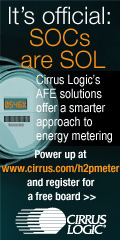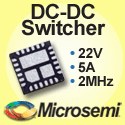HOW2POWER TODAY |
 |
|
ISSUE: September 2010 | |
To ensure receipt of your newsletter, please add david@how2power.com to your address book. | |
 |
IN THIS ISSUE:
» From the Editor’s Desk
» Reader Survey
» Powering RF Systems: Why So Many
Power Supply Designs Have Problems and
What IC Suppliers Should Do About It
» Debunking An Old Myth: Those New Devices
Will Fall Off The Board
» Embed Your Planar Magnetics To Maximize
DC-DC Converter Performance (Part 1)
» Introducing: How2Power’s Power Electronics
Bookstore
» New Power Products
» Other Top News: Online Resources On
Design-Oriented Analysis
» Power Supply Jobs & Technology
From the Editor's Desk David G. Morrison
Editor, How2Power TODAY
|
|
 This issue marks the one year anniversary of How2Power Today. The time, as they say, has just flown by. And while it was flying, the newsletter has run dozens of practical and detailed design articles on a variety power conversion topics and applications. For these articles, we can thank the many experts who have shared their research and experience with How2Power Today. You can learn more about these contributors at How2Power’s Authors Page. This issue marks the one year anniversary of How2Power Today. The time, as they say, has just flown by. And while it was flying, the newsletter has run dozens of practical and detailed design articles on a variety power conversion topics and applications. For these articles, we can thank the many experts who have shared their research and experience with How2Power Today. You can learn more about these contributors at How2Power’s Authors Page.
Unfortunately, there’s a much larger group of contributors to the newsletter, which you won’t get to read about—the readers. Over the past year, as your ranks have grown from a few hundred to a few thousand subscribers, many of you have suggested the topics you’d like to see written about in How2Power Today. This input has been and will continue to be invaluable in shaping the contents of this newsletter.
On a related note, I would like to thank the many engineers, students, and instructors who visited the How2Power booth at the recent Energy Conversion Congress & Exposition (ECCE). I enjoyed speaking with you about How2Power.com, and hearing about your work and your interests. ECCE2010 was an exciting and successful event that drew over 1000 attendees from many different industries, universities, and regions of the world. You’ll be reading more about this conference in the next newsletter. |
READER SURVEY . . |

How2Power Needs Your Feedback
Featured on the How2Power.com home page, the How2Power Design Guide is a free search tool that was created to help you address power supply design challenges. It does so by enabling you to search hundreds of pre-screened, articles on dozens of power conversion and power management topics. But to be truly effective, it requires user feedback. Would you please take a moment to answer a few questions about your experiences using the How2Power Design Guide?
Take the Survey now.
|

HOW2POWER EXCLUSIVE DESIGN ARTICLES 
|

Powering RF Systems: Why So Many Power Supply Designs Have Problems and What IC Suppliers Should Do About It
by Steve Sandler and Charles Hymowitz, AEi Systems, Los Angeles, Calif.
Many power supply designs used to power microwave and RF applications simply don’t work as well as they need to. From the simplest linear regulators, to the switching converters, all the way up to the complete distributed power systems, these designs often fail to meet key specifications such as stability, regulation, ripple, and headroom. This feature examines the variety of technical reasons why these power supply designs perform poorly. It also demonstrates that, in many cases, the problems can be traced back to a lack of adequate information from the power component vendors. Their datasheets simply don’t tell RF system designers what they need to know to develop power conversion circuitry. Nevertheless, this problem presents a great opportunity. And as the authors comment, power IC developers and FAEs—if they are willing—can do a lot to help. The article concludes with an intriguing list of “The Top Ten Things RF Engineers Should Know About Voltage Regulators.” Read the full story…
|  A distributed power architecture relies heavily on linear regulators and filtering to clear up poor dc-dc converter performance. Heavy filtering causes regulators many problems including poor phase margin, which leads to the breakdown of system performance. |


The CTE for PQFN-style packages is between 8 and 12 ppm/°C,
which matches the PCB and traces very well in most any FR4 application. |
Debunking An Old Myth: Those New Devices Will Fall Off The Board
by Paul L. Schimel PE, International Rectifier, El Segundo, Calif.
In the past, leadless semiconductor packages (those with no protruding pins) were something to avoid in the power electronics world. The “forbidden” leadless packages were the BGAs, flip chips, and what we now know as the PQFN packages. Back then, you needed the leads protruding from the package for a little compliance. The coefficient of thermal expansion (CTE) for the plastic package was fairly different from that of the system consisting of the printed circuit board (PCB), traces and solder. Without leads that could flex a little bit, eventually the solder would fracture and failure would ensue. But times have advanced as have the materials. The issue of CTE mismatch is no longer a reason to forego using leadless packages. Nevertheless, when semiconductor FAEs like the author recommend these packages to customers, they still hear this response: “We can’t use those devices—they will fall off the board.” To assure customers that the leadless devices are safe, the author investigated the CTEs of packaging and board materials. His findings are presented here. Read the full story… |

Embed Your Planar Magnetics To Maximize DC-DC Converter Performance (Part 1)
by Harold Eicher, Champs Technologies, East Setauket, NY
Compared with wire-wound magnetic devices, planar magnetics offer advantages such as low profile, improved efficiency, and easier thermal management. However, the time is now for many design engineers to contemplate the switch from the discrete planar magnetic devices to embedded magnetics structures. With embedded planar magnetics, the copper windings for inductors or transformers are formed directly on the user’s PCB and magnetic cores are then assembled over these windings. This approach enables a higher level of design optimization than the discrete planar approach. In this article, the author demonstrates how embedded planar magnetics can be applied to achieve enhanced performance in a digitally controlled dc-dc converter design. The magnetics design described here was originally developed as part of Microchip Technology’s reference design for a dc-dc converter based on the dsPIC33F digital signal controller. In part 1 of this article, procedures are described for designing the main transformer. Read the full story… |

Embedded planar magnetic devices were developed to enhance the performance of this digitally controlled dc-dc converter design. |

INTRODUCING... |

Introducing How2Power’s Power Electronics Bookstore
The most valuable sources of information can also be the hardest-to-find, particularly when those sources relate to power electronics. Frequently cited references are often out-of-print, leaving your technical library incomplete and limiting your access to essential information.
How2Power’s new Power Electronics Bookstore can help!
The Bookstore offers reprints of classic texts and unique reference materials relating to power supply design and power magnetics design. And for those eager to keep pace with the leading-edge of technology, the bookstore offers in-depth and authoritative reports on power supply technology trends.
Visit the Power Electronics Bookstore now to see what you may be missing.
|

 — POWER PRODUCTS IN 3 IMAGES OR LESS — POWER PRODUCTS IN 3 IMAGES OR LESS 
|
 |

Picor’s PI2007 and PI2127 high-side
active ORing devices. |
High-Side Active ORing Devices Deliver Fast Response for Intermediate Bus Applications
 Photo: The PI2007 and PI2127 are high-side active ORing devices aimed at 12-V and 48-V high-side intermediate bus applications. The PI2007 is a universal high-speed active ORing controller; the PI2127 co-packages the ‘2007 controller with a 60-V MOSFET for a compact active ORing solution. Photo: The PI2007 and PI2127 are high-side active ORing devices aimed at 12-V and 48-V high-side intermediate bus applications. The PI2007 is a universal high-speed active ORing controller; the PI2127 co-packages the ‘2007 controller with a 60-V MOSFET for a compact active ORing solution.
 Graph: With its 80-ns reverse current turn-off delay time and 4-A gate peak discharge current capability, the controller can quickly turn off an external MOSFET. Graph: With its 80-ns reverse current turn-off delay time and 4-A gate peak discharge current capability, the controller can quickly turn off an external MOSFET.
 Diagram: For applications requiring active ORing on both sides of the power path, the PI2007 high-side controller can be combined with the PI2003 low-side controller. Diagram: For applications requiring active ORing on both sides of the power path, the PI2007 high-side controller can be combined with the PI2003 low-side controller.
More details… |
 
Texas Instruments’ TPS7A30 negative
36-V low dropout regulator.
|
Negative 36-V LDO Delivers Low-Noise Performance
 Diagram: With its wide, -3.0-V to -36-V input range, the TPS7A30 LDO can generate the negative supply rails needed in industrial applications, while reducing the need for transient voltage protection. Diagram: With its wide, -3.0-V to -36-V input range, the TPS7A30 LDO can generate the negative supply rails needed in industrial applications, while reducing the need for transient voltage protection.
 Diagram: The TPS7A30 negative LDO may be paired with the TPS7A49 positive LDO to generate the clean supply rails required for powering precision analog circuitry. Diagram: The TPS7A30 negative LDO may be paired with the TPS7A49 positive LDO to generate the clean supply rails required for powering precision analog circuitry.
 Graph: Configured for +12 and -12-V outputs, the LDOs attenuate the ripple generated by a dc-dc converter switching at 300 kHz. Graph: Configured for +12 and -12-V outputs, the LDOs attenuate the ripple generated by a dc-dc converter switching at 300 kHz.
More details… |
 
iWatt’s iW1810 digitally controlled
PWM IC with built-in BJT.
|
Power Chip Builds Efficient, Low-Cost Supplies for Industrial Applications
 Diagram: Aimed at industrial applications, the iW1810 digitally controlled PWM IC with a built-in 800-V bipolar power transistor, requires few external components to complete a low-wattage ac-dc power supply. Diagram: Aimed at industrial applications, the iW1810 digitally controlled PWM IC with a built-in 800-V bipolar power transistor, requires few external components to complete a low-wattage ac-dc power supply.
 Table: A 3-W ac-dc power supply based on the iW1810 easily meets the Energy Star 2.0 specification for external power supplies. Table: A 3-W ac-dc power supply based on the iW1810 easily meets the Energy Star 2.0 specification for external power supplies.
More details… |
| 





|

 |  |

POWER SUPPLY JOBS & TECHNOLOGY
|

The Grid Powers Opportunities in Power Electronics R&D
Power electronics is playing an important role in the development of grid-related technologies such as renewable energy systems and others associated with the development of the Smart Grid. Global corporations such as General Electric, Siemens, and ABB have a large stake in the development of these technologies, and are now recruiting an impressive number of power electronics engineers to perform the research and development needed to bring these technologies to market. You can read about the new opportunities in “Global Companies Expand Power Electronics R&D To Develop Grid Technologies And More,” in the September issue of Power Systems Design. |


OTHER TOP POWER NEWS |

Online Resources On Design-Oriented Analysis
Readers interested in Design-Oriented Analysis (D-OA), an engineering approach and set of tools developed by the late Dr. David Middlebrook, should check out Garrett Neaves’ website, which was created “to enhance collaboration between those interested in learning and applying D-OA.” Neaves’ website provides an introduction to the D-OA topic, including a basic definition, some history, thoughts on why it’s not widely taught in schools, and links to D-OA resources. Among those resources is Dr. Middlebrook’s website, which continues to be maintained despite his passing. On this website, Dr. Middlebrook's DVDs are still available for a nominal charge.
|

 — RECOGNIZING TODAY'S POWER ACCOMPLISHMENTS — RECOGNIZING TODAY'S POWER ACCOMPLISHMENTS 
|

The CPES faculty for winning three ARPA•E (Advanced Research Projects Agency • Energy) awards totaling $2.86 million for three years. The awards were given for Power Supplies on a Chip, Isolated Converter with Integrated Passives and Low Material Stress, and Gallium-Nitride Switch Technology for Bi-directional Battery-to-Grid Charger Applications. Click here for more details.
|


ABOUT THIS NEWSLETTER: Thank you for reading HOW2POWER TODAY.
How2Power sends no more than one e-mail per month to registered users. Continuing your subscription ensures you'll receive future newsletters. Manage Your Subscription
©2010 All rights reserved. www.how2power.com
|